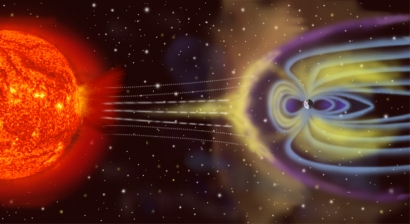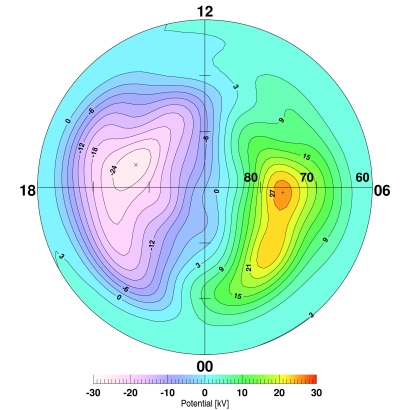 A black hole is a region of space in which gravity is so strong that not even light can escape. Typical black holes range in size from stellar-mass black holes (which form mainly via the collapse of a massive star) to supermassive black holes which reside in the cores of galaxies. It is assumed that most galaxies contain a supermassive black hole at their core. Till recently, many black holes had been "missing." However, using both Spitzer (an infrared space telescope) and Chandra (an x-ray space telescope), a large fraction of these black holes have been found. The picture to the right is an artists conception of a growing black hole/quasar.
A black hole is a region of space in which gravity is so strong that not even light can escape. Typical black holes range in size from stellar-mass black holes (which form mainly via the collapse of a massive star) to supermassive black holes which reside in the cores of galaxies. It is assumed that most galaxies contain a supermassive black hole at their core. Till recently, many black holes had been "missing." However, using both Spitzer (an infrared space telescope) and Chandra (an x-ray space telescope), a large fraction of these black holes have been found. The picture to the right is an artists conception of a growing black hole/quasar.These black holes, due to their energetic nature, are considered quasars. A quasar or QUASi-stellAR radio source is a compact halo of matter surrounding a supermassive black hole within a young galaxy. These black holes/quasars were found within Milky Way mass galaxies of irregular shape at 9 to 11 billion light years away.
 A team lead by Emanuele Daddi (of the Commissariat a l'Energie Atomique in France) studied 1,000 galaxies and found that, using Spitzer, 200 of those had an overabundance of infrared light. When studied with Chandra, the team found quasars within those 200 galaxies. The picture on the left shows an area of the sky containing galaxies with quasars in them (those galaxies are circled). This picture was taken using the Spitzer space telescope. It is thought that the quasars heat the dust surrounding them, thus giving off infrared light.
A team lead by Emanuele Daddi (of the Commissariat a l'Energie Atomique in France) studied 1,000 galaxies and found that, using Spitzer, 200 of those had an overabundance of infrared light. When studied with Chandra, the team found quasars within those 200 galaxies. The picture on the left shows an area of the sky containing galaxies with quasars in them (those galaxies are circled). This picture was taken using the Spitzer space telescope. It is thought that the quasars heat the dust surrounding them, thus giving off infrared light.The finding of these new quasars has helped to change the way we think that massive galaxies evolve. It is now believed that the stars and black holes in massive galaxies form together until the black hole gets too massive, at which point it stops star formation. Additionally, in the past, it was believed that galaxy mergers played a large part in ignition of quasar activity, but seeing so many unscathed galaxies, it is now believed this is not true.
Finding so many new black holes in old galaxies will help us further refine our theories on galaxy/black hole formation in the early universe. This further knowledge can also aid us in our studies in the future. I also look forward to finding out what else Spitzer and Chandra can find and tell us about the universe.
NASA article:
http://www.nasa.gov/mission_pages/spitzer/news/spitzer-20071025.html
Space.com article:
http://www.space.com/scienceastronomy/071025-missing-bholes.html



